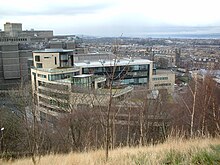
Edinburgh is the capital city of Scotland and one of its 32 council areas. The modern city is located between the rivers Almond and Esk on the southern shore of the Firth of Forth, in the historic region of Lothian, bounded on its southern side by the Pentland Hills. Edinburgh is the second-most populous Scottish city and the seventh-most populous city in the United Kingdom.
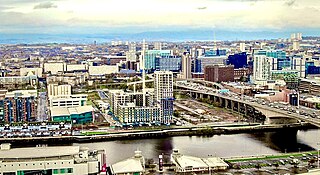
Glasgow is the most populous of the eight cities of Scotland and is the third-most populous city in the United Kingdom, as well as being the 27th largest city by population in Europe. In 2022, it had an estimated population as a defined locality of 632,350 and anchored an urban settlement of 1,028,220. Formed as a county of itself in 1893, the city had previously been in the historic county of Lanarkshire and has also grown to include settlements that were once part of Renfrewshire and Dunbartonshire. It now forms the Glasgow City Council area, one of the 32 council areas of Scotland, and is administered by Glasgow City Council.

Edinburgh Trams is a tramway in Edinburgh, Scotland, operated by Edinburgh Trams Ltd. It is a 18.5-kilometre (11.5 mi) line between Newhaven in Leith and Edinburgh Airport, with 23 stops.
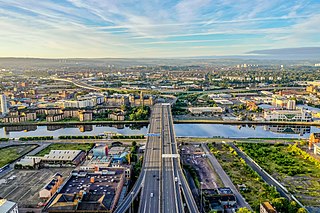
The city of Glasgow, Scotland, has a transport system encompassing air, rail, road and an underground light metro line. Prior to 1962, the city was also served by trams. Commuters travelling into Glasgow from the neighbouring local authorities of North and South Lanarkshire, Renfrewshire, East Renfrewshire, and East and West Dunbartonshire have a major influence on travel patterns, with tens of thousands of residents commuting into the city each day. The most popular mode of transport in the city is the car, used by two-thirds of people for journeys around the city.
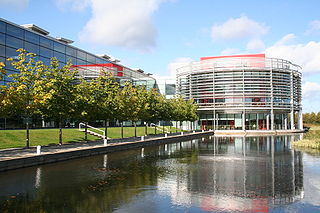
Edinburgh Park is an out-of-town business park in South Gyle, Edinburgh, Scotland. It is west of the city, near Edinburgh Airport and adjacent to the Edinburgh City Bypass. It was opened in 1995. The layout of the park was masterplanned by American architect Richard Meier. Edinburgh Park railway station, which is on the Glasgow to Edinburgh via Falkirk Line, opened in December 2003. Edinburgh Gateway station on the Fife Circle Line is also nearby.
Sighthill is a suburb in the west of Edinburgh, Scotland. The area is bordered by Broomhouse and Parkhead to the east, South Gyle to the north, the industrial suburb of Bankhead and the Calders neighbourhood to the west, and Wester Hailes to the south. It is sometimes included in the Wester Hailes area, while the Calders, Bankhead and Parkhead are sometimes considered parts of Sighthill. Administratively it has formed a core part of the City of Edinburgh Council's Sighthill/Gorgie ward since 2007.

South Gyle is an area of Edinburgh, Scotland, lying on the western edge of the city and to the south and west of an area of former marshland once known as the Gogarloch, on the edge of Corstorphine. Most of the buildings in the area are of recent origin, dating from the later 1980s, 1990s, and early 21st century, with the exception of some farm workers' cottages and an early 1970s council estate abutting South Gyle railway station.

The economy of Scotland is an open mixed economy which, in 2023, had an estimated nominal gross domestic product (GDP) of £211.7 billion including oil and gas extraction in Scottish waters. Since the Acts of Union 1707, Scotland's economy has been closely aligned with the economy of the rest of the United Kingdom (UK), and England has historically been its main trading partner. Scotland still conducts the majority of its trade within the UK: in 2017, Scotland's exports totalled £81.4 billion, of which £48.9 billion (60%) was with the countries of the United Kingdom, £14.9 billion with the European Union (EU), and £17.6 billion with other parts of the world. Scotland’s imports meanwhile totalled £94.4 billion including intra-UK trade leaving Scotland with a trade deficit of £10.4 billion in 2017.

Edinburgh Park railway station is a railway station in the west of Edinburgh, Scotland, serving the Edinburgh Park business park and the Hermiston Gait shopping centre. The new station building was designed by IDP Architects, and it opened on 4 December 2003. It is the first intermediate station between Haymarket and Linlithgow since 1951. Ticket barriers came into use on 25 March 2015.

Edinburgh is a major transport hub in east central Scotland and is at the centre of a multi-modal transport network with road, rail and air communications connecting the city with the rest of Scotland and internationally.

Gogar is a predominantly rural area of Edinburgh, Scotland, located to the west of the city. It is not far from Gogarloch, Edinburgh Park and Maybury. The Fife Circle Line is to the north.

Maybury is an area on the western edge of Edinburgh, Scotland, near South Gyle and Ingliston, named after the road, which is itself named after the civil engineer Sir Henry Maybury (1864–1943). In 2021, residents have been undertaking community clean ups to clear the foot paths along the road. The area is residential in the north east/east and commercial in the south and west and The Gyle Shopping Centre is nearby. In 2021, there was a consultation about creating a Primary School and Health Centre in Maybury.

The economy of Leeds is the most diverse economy of all the UK's main employment centres and has seen the fastest rate of private-sector jobs growth of any UK city and has the highest ratio of public to private sector jobs of all the UK's Core Cities. Leeds has the third-largest jobs total by local authority area with 480,000 in employment and self-employment at the beginning of 2015. Leeds is the largest legal and financial centre in England outside of London, and third largest in the UK after Edinburgh, and in 2011 its financial and insurance services industry was worth £2.1 billion. with more than 30 national and international banks located in the city. Leeds is also the UK's third largest manufacturing centre with around 1,800 firms and 39,000 employees, Leeds manufacturing firms account for 8.8% of total employment in the city. The largest sub-sectors are engineering, printing and publishing, food and drink, chemicals and medical technology. Leeds is also ranked as a gamma world city by the Globalization and World Cities Research Network; Over the next ten years, the economy is forecast to grow by 25% with financial and business services set to generate over half of GVA growth over that period with Finance and business services accounting for 38% of total output. Other key sectors include retail, leisure and the visitor economy, construction, manufacturing and the creative and digital industries.

The Glasgow Airport Rail Link (GARL) is a proposed link between Glasgow City Centre and Glasgow Airport. The original plans for an airport rail link were proposed during the 2000s to directly link Glasgow Central station with Glasgow Airport in Scotland. The link was intended for completion by 2013 and would have had a service of four trains per hour via Paisley Gilmour Street railway station.

Gyle Shopping Centre is a shopping center located in the South Gyle area of Edinburgh, Scotland. The main centre has two anchor tenants, Marks & Spencer and Morrisons, at opposite ends of the shopping centre.
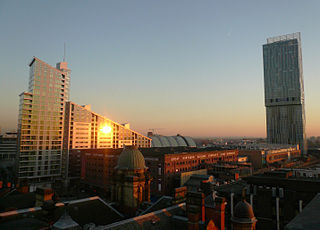
The economy of Manchester is among the largest in England. Manchester is a city and metropolitan borough of Greater Manchester. It lies within the United Kingdom's second-most populous urban area, with a population of 2.55 million. Manchester's commercial centre is in Manchester city centre, focused on Spinningfields, Mosley Street, Deansgate, King Street and Piccadilly Gardens.

Edinburgh Gateway station is a railway station and interchange at Gogar in Edinburgh, Scotland, which opened on 11 December 2016. It is served by ScotRail and Edinburgh Trams, and serves both Gogar and Edinburgh Airport, to which it is connected by the tram line.

The economy of Liverpool encompasses a wide range of economic activity that occurs within and surrounding the city of Liverpool, England. With a population of over 1.3 million in its Larger Urban Zone, and a metropolitan area population of 2,241,000, Liverpool is one of the largest cities in the United Kingdom and sits at the centre of the broader Merseyside economic area, which is itself one of the two core economies of the North west of England. In 2017 the Liverpool City Region experienced the UK's highest growth in real GVA, increasing by 3.3%.
Various studies, from 1989 onwards, considered the reintroduction of trams to Edinburgh. In 2001, a proposal for a new Edinburgh Trams network envisaged three routes across the city, Lines 1, 2 and 3. Line 1 was a circular route running around the northern suburbs, with the other two forming radial lines running out to Newbridge in the west and to Newcraighall in the south respectively. All lines would run through the city centre.


